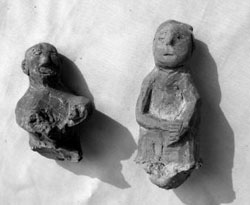
Chinese archaeologists have discovered two terracotta figurines
dating back to about 2,500 years ago, older than the famous
terracotta warriors buried with first Chinese emperor
Qinshihuang.
The rough-hewn, 10-centimeter tall statues might be the oldest
terracotta figurines produced by the Qin State at the beginning of
the Warring States Period (475 BC-221 BC), said some experts.
The two figurines were found at the ruins of Yongcheng, an
ancient Qin State capital, in northwest Shaanxi Province, according
to local media reports.
Qin State unified China in 221 BC. Qinshihuang, the first
emperor of a unified China, built the first Great Wall and ordered
up a giant mausoleum for himself outside today's Xi'an, capital of
Shaanxi Province, guarded by an estimated 8,000 life-size pottery
warriors and horses.
The newly found small terracotta figurines might have been used
to decorate houses, said an archaeologist.
The figurines were unearthed at the relics site of an ancient
ceramics workshop. More than 2,000 pieces of roof tile were also
found.
This is the first time such a large number of Qin State roof
tiles have been discovered, said Tian Yaqi, a researcher with the
Institute of Archaeology of Shaanxi Province.
Roof tiles were used on ancient buildings in China, usually
engraved with characters and patterns. Fifteen different types of
animal pattern - including tigers, phoenixes, toads and deer --
have been found on the tiles.
The relics site, which was accidentally discovered by local
farmers, has drawn considerable interest from cultural heritage
departments.
(Xinhua News Agency August 15, 2006)

